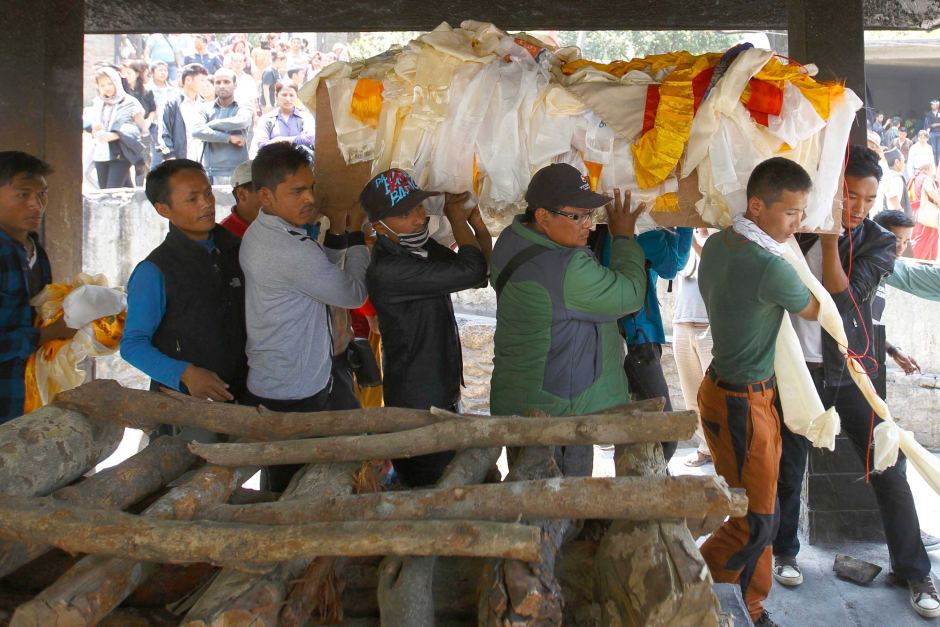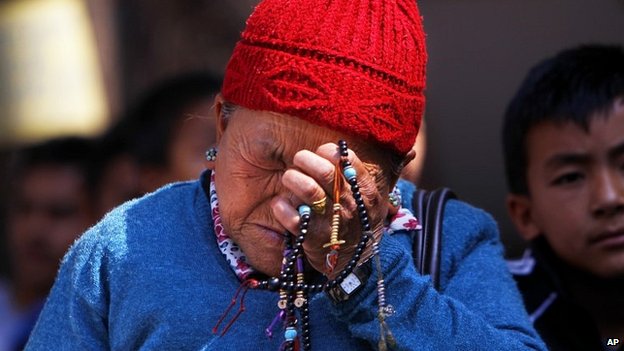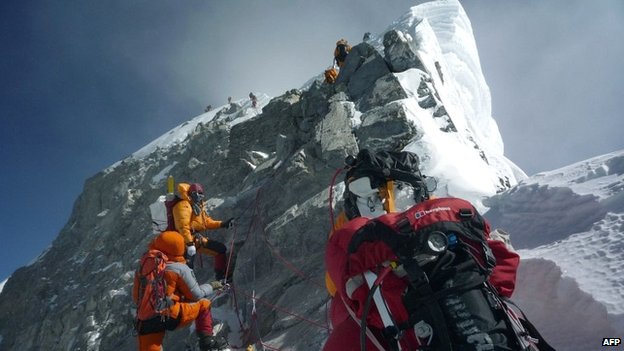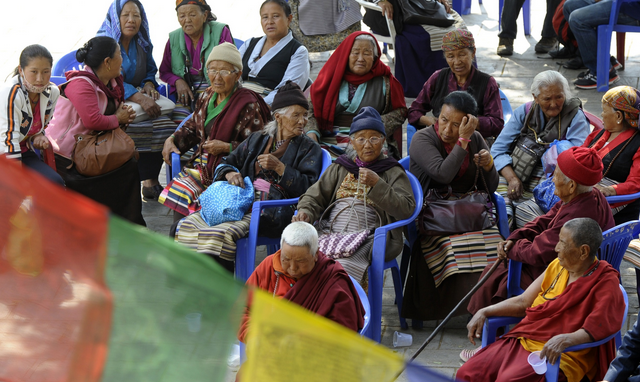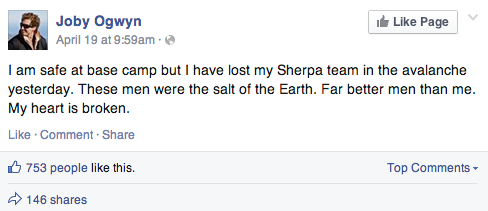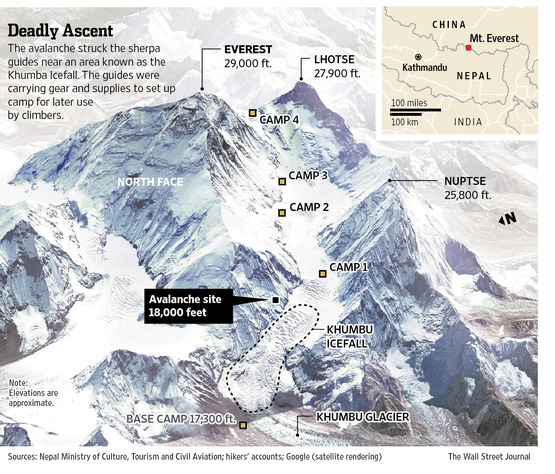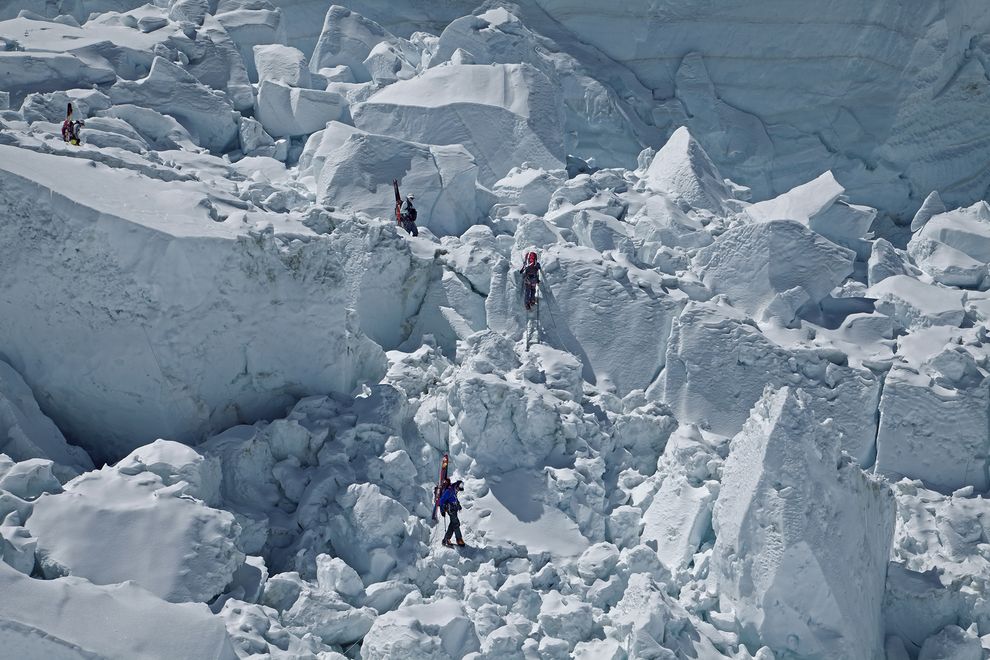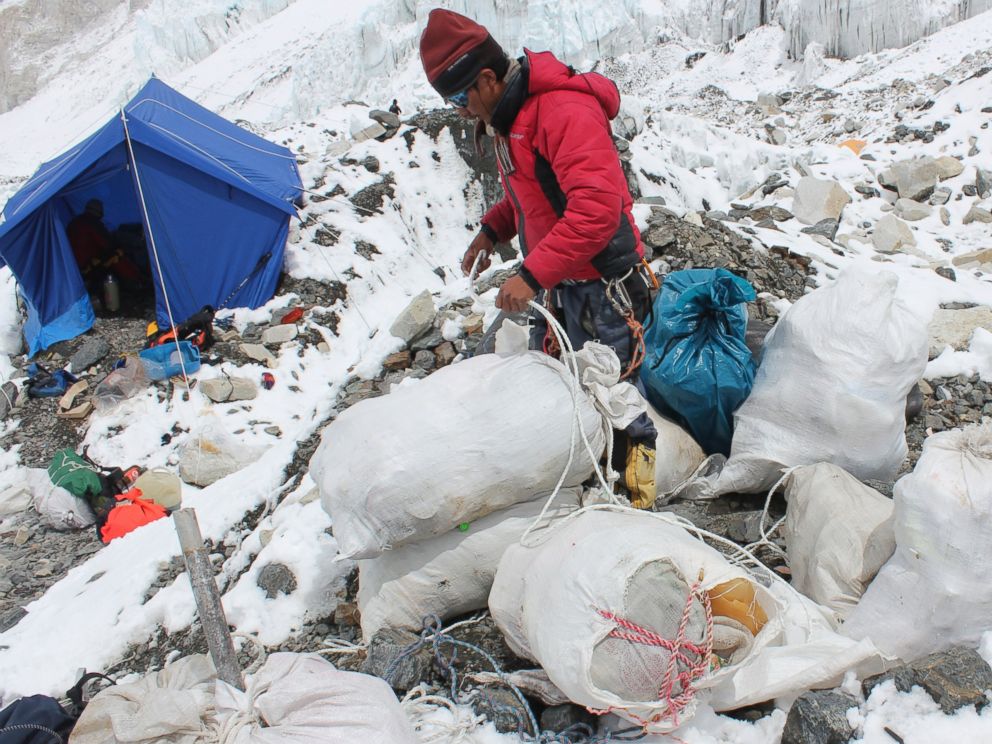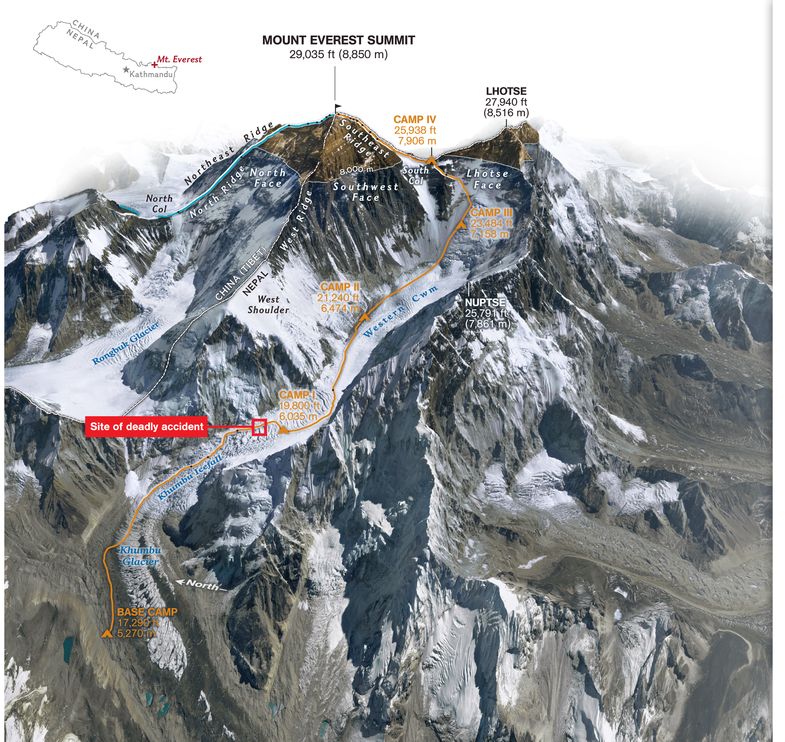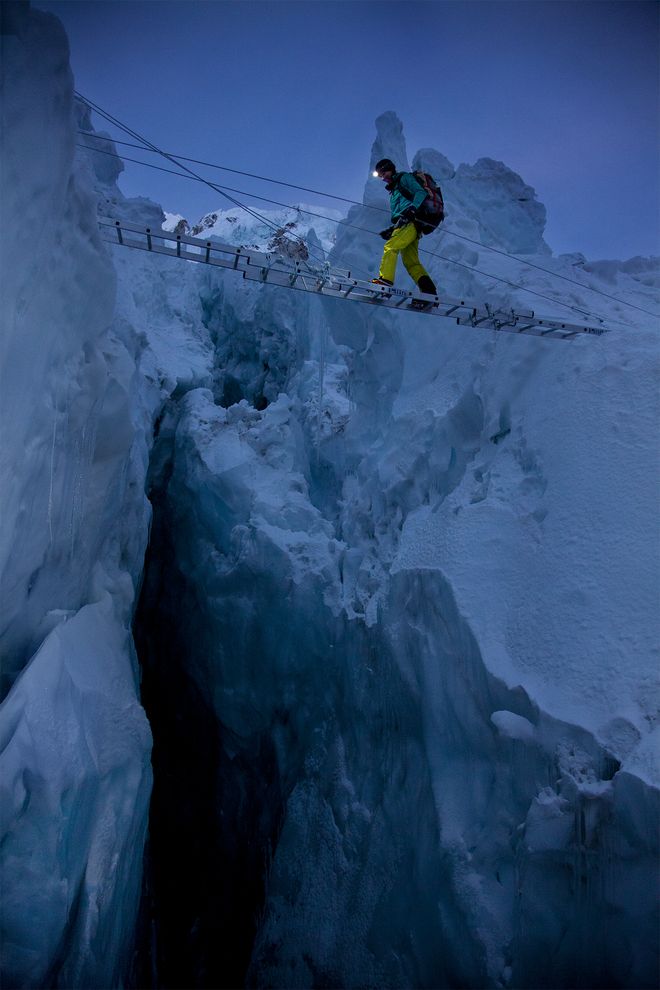Mt. Everest Avalanche: Latest Updates Of The Deadliest Everest Accident Ever
On 18 April 2014, the deadliest avalanche to occur on the world's highest peak near Everest Base Camp killed at least sixteen Nepalese guides.
Mt. Everest Avalanche: Sherpas Shut Down The Rest Of This Year's Climbing Season
Relatives and friends farewelled one of the dead sherpas, Ankaji Sherpa, in a cremation ceremony in Kathmandu on Monday.
Image via abc.net.auAfter sixteen of their colleagues lost their lives on the first climbing day of the year, Mount Everest's sherpa guides voted on Tuesday to end the 2014 climbing season entirely, the AFP reported. Some of the guides have already left the mountain in mourning for their colleagues, while others will pack up and follow suit soon.
Although the sherpas threatened to quit this season unless the government awarded them higher compensation for their grueling, risky jobs, the vote to end the season now is mainly about honoring the dead. "How can we step on it now?" Pasang Sherpa told the AFP, "Sixteen people have died on this mountain on the first day of our climb."
The families of the sherpa guides who died denounced the Nepalese government's initial offer of compensation
Image via bbcimg.co.ukThe disaster has brought to the surface long-simmering tensions over how the government shares out millions of dollars in revenue from the annual pursuit of the Everest summit, with sherpas denouncing its initial $400 (RM1306) compensation offer for the families of their dead compatriots. But the expedition leader said the disaster was a "wake-up call" for the whole climbing business and that "things would have to change".
abc.net.auThe tragedy has highlighted what all those who climb the mountain know - that Nepalese guides take most of the risks and most of the load. But commercial climbing on Everest and other big peaks has also become crucial to Nepal's economy. All those who died were so-called "icefall doctors", doing one of the riskiest jobs of all, which involves finding a route through the twisting, broken mass of the Khumbu icefall, and then securing rope lines and ladders over the crevasses for foreign mountaineers to follow.
The avalanche that struck above Everest base camp last week killed 16 local guides
Image via bbcimg.co.ukEverest Sherpas Angered By Government's Offering Of Only RM1,300 To Families Of Avalanche Victims
Relatives of Mount Everest avalanche victims wait for the mortal remains of their loved ones to arrive at the Sherpa Monastery in Kathmandu on April 19, 2014.
Image via Getty ImagesSherpas have also been angered by the government offering families of the victims $400 (£238) which will only cover funeral costs.
The Sherpas have expressed anger that there has not been a bigger response from Nepal's government, which profits from the permit fees charged to the climbing expeditions.
adn.comExpedition leaders, politicians and leading Sherpas have agreed to lobby the government to improve compensation for guides. Sherpas feel they do not get a fair share of climbing royalties but are expected to take a disproportionate amount of the risk and demonstrations are planned before the funerals take place this week.
On Monday, 21 April 2014, Deputy Prime Minister Prakash Man Singh said the government is working to help the Sherpas. "It is not true the government does not care," he said. "We have been working with rescue from the very beginning. We will do what we can, keeping with the standard practice to provide compensation. "
adn.comDiscovery Channel Cancels "Everest Jump Live" In Light Of Deadly Avalanche
Discovery Channel has canceled its live broadcast of a Mount Everest jump by Joby Ogywn.
Image via Discovery ChannelDiscovery Channel was planning to air a live jump from Mt. Everest (scheduled for 11 May), following professional climber Joby Ogwyn as he made the leap. However, the devastating avalanche forced the net to change plans.
The network released a statement Sunday saying, "In light of the overwhelming tragedy at Mt Everest and respect for the families of the fallen, Discovery Channel will not be going forward with Everest Jump Live. Our thoughts and prayers go out to the whole Sherpa community."
Discovery's Mount Everest prime-time special had been in the works for months. In February, the network announced that climber Joby Ogwyn was set to scale the summit of Everest and then jump off it in a wing suit, on live TV, for the broadcast. It would be the latest real-time spectacle — something that could be a social media hit.
Mt. Everest Avalanche: Death Toll Reaches 13 With Three Still Missing
Nepalese rescue team members rescue a survivor of an avalanche on Mount Everest on Friday. At least 13 Nepalese guides preparing routes up Mount Everest for commercial climbers were killed by an avalanche in the most deadly mountaineering accident ever on the world’s highest peak, officials and rescuers say.
Image via ticotimes.netRescuers recovered the body of one mountain guide yesterday after an ice avalanche swept the lower slopes of Mount Everest, bringing the death toll to at least 13 in the deadliest accident on the world's highest mountain.
The avalanche struck a perilous passage called the Khumbu Icefall, which is riddled with crevasses and piled with serac – or huge chunks of ice – that can break free without warning. All of the victims were Sherpa mountain guides.
Shocked relatives wondered how they would cope without the men who take huge risks to earn up to USD5,000 (about RM16,202) for a two-month expedition – around 10 times the average annual pay in Nepal. "He was the only breadwinner in the family," said 17-year-old Phinjum Sherpa, as she waited for the body of her uncle, Tenji Sherpa, at a Buddhist monastery in Kathmandu. "We have no one to take care of us."
A child cries as family members mourn the deaths of Nepali mountaineering guides who were killed in Friday's avalanche on Mount Everest, at Sherpa Monastery in Kathmandu April 19, 2014
Image via independent.ieAlthough relatively low on the mountain, climbers say the icefall is one of the most dangerous places on Mount Everest. There are, however, no safer paths along the famous South Col route scaled by Edmund Hillary and Tenzing Norgay in 1953. The incident was the first major avalanche of this year's climbing season on Everest, which has been scaled by more than 4,000 climbers.
In The Deadliest Day In Mount Everest's History, An Avalanche Killed 12 Sherpa Guides And Left Four Missing, Another Six Are Reportedly Injured
A photo of the avalanche on Mount Everest, where 12 people were believed dead Friday.
Image via instagram.comNepal's Sherpa community is confronting a dark tragedy after at least 12 guides were killed by an avalanche that swept down a climbing route on Mt Everest. A search was ongoing for at least four more guides still missing following the deadliest ever single day on the world's highest mountain.
Officials said the men were killed after the avalanche struck at around 6.30am on Friday as they were laying fixed ropes for other climbers. Rescue workers struggled to pull their bodies from mounds of snow and ice after they were struck just about Camp 2. Two men, who survived but suffered injuries, were lifted from the ice debris and flown by helicopter to Kathmandu.
"We fear there are still a few more buried in the snows there," said Mr. Shrestha, who works for Nepal's Tourism Ministry as a liaison officer for Everest expeditions. He said searchers would resume work at dawn Saturday.
wsj.comAll The Climbers Involved Were Of Nepali Origin (Famously Referred To As Sherpas) And Had Been Preparing The Route Ahead Of The Main Spring Climbing Season, Which Starts In A Matter Of Days
Nepalese Mountaineer and Mount Everest avalanche survivor Sherpa Tashi Daba undergoes treatment at the Intensive Care Unit of Grande Hospital in Kathmandu, Nepal, Friday.
Image via wsj.net"The sherpa guides were carrying up equipment and other necessities for climbers when the disaster happened," a spokesman for Nepal's Tourism Ministry, Mohan Krishna Sapkota, told the AFP news agency.
wsj.comThe Sherpas Always Go First, Edging Up The Deadly Flank Of Mount Everest While International Clients Wait For Days In The Base Camp Below
This Map Shows The Main Climbing Route Up Mount Everest, Where The Deadly Avalanche Struck Friday
Image via wsj.netThey set off in the dark, before the day’s warmth causes the ice to shift. They creep one by one across ladders propped over crevasses, burdened with food and supplies, all the while watching the great wall of a hanging glacier, hoping that this season will not be the year it falls. On Friday, however, it did.
The Avalanche Is Said To Have Struck In An Area Known As The "Popcorn Field"
The area lies on the route towards the notorious Khumbu ice fall, an unavoidable passage which has claimed the lives of many climbers over the years.
Hundreds of foreign and local climbers have gathered at the base camp of Everest to prepare for attempts on the 29,035-foot mountain early next month when weather conditions become optimal and provide a small, brief window of opportunity for people to realise their ambitions. In preparation, teams of sherpas have been setting up fixed ropes that their clients, who pay many thousands of pounds to scale the peak, will attach themselves to while ascending the mountain.
wsj.comIn recent years the number of climbers in Everest, especially those with less experience, has soared and the Nepalese authorities have introduced measures to try and better organise the flow. Officials have been dispatched to base camp to spend the climbing season there and address any problems
Although The Term "Sherpa" Has Long Been A Part Of The Popular Lexicon, Outsiders Generally Know Little About The Role They Play In Himalayan Climbing
In this May 18, 2013 file photo released by mountain guide Adrian Ballinger of Alpenglow Expeditions, climbers make their way to the summit of Mount Everest, in the Khumbu region of the Nepal Himalayas.
Image via mshcdn.comThe Sherpas are a small ethnic group that share many cultural, racial, and linguistic features with Tibetans, who live to their immediate north. About 3,000 Sherpas reside in the drainage areas immediately below Everest; a population of 20,000 or more live in villages to the south. Until the early 1950s, no high Himalaya peak in Nepal had ever been climbed—at least by mortals, the Sherpas say. Then, as now, they saw the Himalayan peaks and foothills as the realm of a cavorting pantheon of gods.
Presciently, a prominent Sherpa Buddhist lama predicted about 80 years ago that much attention would come to be focused on Everest, and that people would "suffer hardship as a result of negative deeds generated in her vicinity." The Buddhist lamas, the spiritual leaders of the Sherpa community, say that one's motivation in climbing Everest and the nearby peaks is of key importance.
Foreign climbers, when asked why they climb mountains, offer a range of responses: Testing one's limits. Personal achievement. Companionship in a shared challenge. Escape. Fun. Spiritual understanding. One Everest climber admitted that he merely wanted a bullet point on his resume. By comparison, Sherpas share a rather straightforward motivation: Mountaineering is their livelihood, and they do it to support their families.
It's tough, seasonal work—similar to the role of commercial fishing in Alaska for enterprising college students. They approach the task with good cheer, and the pay is exceptional by Nepal's standards (high-altitude Sherpas earn several times the prime minister's monthly salary). Nonetheless, wives of Sherpas—it's a mostly male endeavor—are known to hike to Base Camp to persuade their husbands to give up expedition work.
The Sherpas and the sahibs—the Sherpas' generic, not necessarily deferential, moniker for foreign climbers—share an extremely close relationship. And it's an unusual one, in cross-cultural terms, given that they originate in such different worlds. They have found a near perfect symbiosis on the side of Mount Everest. Each provides for the other what they lack: manpower for the sahibs, money for the Sherpas.
This picture taken on May 26, 2010 shows a Nepalese sherpa packing garbage collected from the Everest clean-up expedition at Everest Base Camp.
Image via abcnews.comBut the dynamic goes beyond this. They each embody the romantic human ideal that each is striving for: The sahibs see the Sherpas as spiritual, grounded, resourceful, self-effacing, and light-hearted. To the Sherpas, the well-educated sahibs have an enviable command of technology and organization. In many ways, they want to become more like each other. For Sherpas and foreign guides, the job of establishing and fixing a route up Everest can be described as a tense work situation. They toil long hours together or beside each other.
Friday's Deaths Easily Surpassed The Previous Highest Number Of Deaths On Mount Everest
Friday's avalanche happened at 19,000 feet (5,800 meters) in an area known as the "popcorn field."
Image via nationalgeographic.comWhile more than 200 people have died whilst climbing Mount Everest, the incident was the single deadliest in the mountain's history, superseding the 1996 disaster in which eight foreign climbers died. Six Nepalese guides died in an avalanche in 1970.
A climber steps across a bridge of aluminum ladders lashed together above a crevasse in the Khumbu Icefall.
Image via nationalgeographic.comFriday's deaths underscore the perilous work undertaken by the sherpas, who lug ropes, tents and supplies for foreign climbers. It was reported that Kathmandu-based climbing company Himalayan Climbing Guides Nepal had confirmed two of their guides were among the dead and other employees were among those still missing
